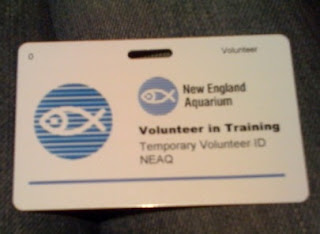#23...check

I am on a roll, and I'm not stopping anytime soon. Finally, after three interviews and three months of waiting, I'm officially a volunteer-in-training at the New England Aquarium and crossing off another item on my to-do list.
Not only am I meeting cool new people who share my love for sea creatures, but I'm also learning lots of interesting 'biofacts' (and totally annoying my friends with my new trivia). Here are some of the highlights from my first class:
- Octopuses are so smart that they're sometimes called the "primates of the sea." This also means that they can be troublemakers when they're bored. A while back, the giant Pacific octopus was sneaking out of his aquarium and treating himself to midnight snacks in the adjacent tank. For weeks, researchers were mystified by the disappearance of the flounder because the octopus always returned to his tank before morning. Finally, someone caught him red-handed. Now, the octopus has to solve elaborate puzzles in order to get his food.
- Also, octopuses have three hearts. (wow)
- Have you seen the octopus vs. shark video? It just might be my favorite marine animal.
- Cordova is the most vocal of all the fur seals. In fact, one night she was so loud that a neighbor actually called 9-1-1. He was convinced that someone was hurt/trapped near the doc.
- Sea otters have one million hairs per square inch of their skin. One million.
- Northern fur seals are an extreme example of sexual dimorphism. Adult males are 30-40 percent longer and about 4.5 times heavier than adult females. In other words, males grow up to be about 7 feet long and 600 pounds, while females are only 4.5 feet long and 120 pounds. (whoa)
- After northern fur seals mate, it takes about three months for the fertilized egg to drop into the uterus.


Comments